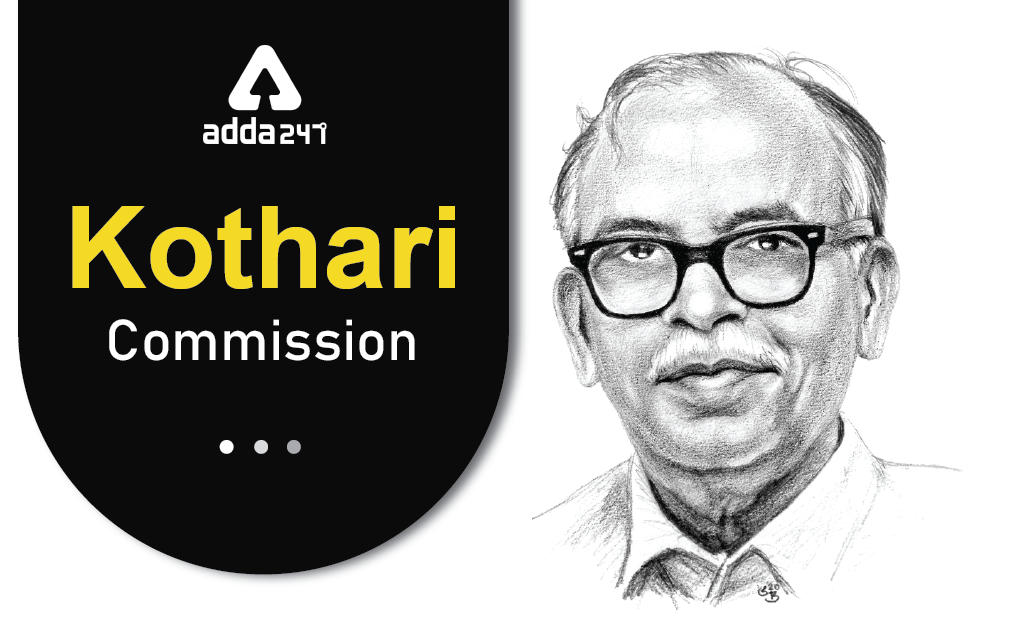Table of Contents
What is the Kothari Commission?
Kothari Commission (1964-66) कोठारी आयोग in Hindi is an important topic that comes in TET and teaching recruitment Examinations. Kothari Commission carries 2-3 marks questions in teaching exams i.e. RPSC, UGC NET, CTET, HTET, KVS, AEES. Kothari Commissions comes in all levels of teaching exams i.e. primary level, upper primary level, and higher education level. Here, we are providing you topic-wise Child Development and Pedagogy notes for helping you in your preparation. Today’s Child Pedagogy topic is: Kothari Commission
Kothari Commission Facts (1964-66)(कोठारी आयोग)
The appointment of the education commission of 1964-1966 popularly known as the ‘Kothari Commission’ was a significant event in the history of education in free India. In 1964, Dr. D.S Kothari was requested to give advice to the government on the action to be taken for the development of education at all levels and he submitted a report in 1966.
It tried to cover every field and aspect of the entire educational system. It is a firm belief that education is the most powerful instrument of national development. The opening sentence of the commission, the destiny of India is being shaped in her classrooms, denotes the value of education that determines the level of prosperity, welfare, and future of the country.
1964-1966 के शिक्षा आयोग की नियुक्ति जिसे ‘कोठारी आयोग’ के नाम से जाना जाता है, स्वतंत्र भारत में शिक्षा के इतिहास में एक महत्वपूर्ण घटना थी।1964 में डॉ. डी.एस. कोठारी से सभी स्तरों पर शिक्षा के विकास के लिए की जाने वाली कार्रवाई पर सरकार को सलाह देने का अनुरोध किया गया और उन्होंने 1966 में एक रिपोर्ट प्रस्तुत की।इसने संपूर्ण शिक्षा प्रणाली के हर क्षेत्र और पहलू को कवर करने का प्रयास किया।इसका दृढ़ विश्वास है कि शिक्षा राष्ट्रीय विकास का सबसे शक्तिशाली साधन है। आयोग का उद्घाटन वाक्य, भारत की नियति को उसकी कक्षाओं में आकार दिया जा रहा है, यह शिक्षा के मूल्य को दर्शाता है, जो देश की समृद्धि, कल्याण और भविष्य के स्तर को निर्धारित करता है।
Kothari Commission Highlights
| Commission Name | Kothari Commission |
| Commission Official Name | Education for National Development |
| Established on | July 14, 1964 |
| Reports Submitted on | June 29, 1966 |
| Chairman | Dr. Dulat Singh Kothari (D.S Kothari) |
| Total Members | 17 |
| Headquarters | New Delhi, India |
| Purpose | to examine all aspects of the educational sector in India |
| Objective |
The recommendations of the Commission cover almost all aspects and all stages of education. The commission suggested for urgent reforms needed in education to transform it, to endeavour to relate it to the life, needs and aspirations of the people and thereby to make it a powerful tool of social, economic and cultural transformation necessary for realisation of our national goals. |
| Recommendations |
|
Kothari Commission Objective
The Commission suggested strategies and targets to achieve and development or women’s education: The Commission states that the overall objective should be to provide educational facilities to boys and girls, to aim for 100% girls enrollment in the age group of 6-11 years by 1976, and in the age-group 11 -14 by 1981.
आयोग ने महिला शिक्षा को प्राप्त करने और विकास के लिए रणनीति और लक्ष्य का सुझाव दिया: आयोग का कहना है कि लड़कों और लड़कियों को शैक्षिक सुविधाएं प्रदान करना समग्र उद्देश्य होना चाहिए, 1976 तक 6-11 वर्ष की आयु समूह में 100% लड़कियों का नामांकन और 1981 तक 11 -14 वर्ष के आयु-समूह का लक्ष्य होना चाहिए।
Education of Girls at Primary Stage
The education of girls should be given special attention for the fulfillment of constitutional directive. प्राथमिक स्तर पर लड़कियों की शिक्षा: संवैधानिक निर्देश की पूर्ति के लिए लड़कियों की शिक्षा पर विशेष ध्यान दिया जाना चाहिए।
Education of Girls at the Secondary Stage
At this stage efforts should be made to accelerate and expand girls education. Emphasis should be placed for establishing separate schools for girls. Moreover facilities like hostels, scholarships and vocational courses should be provided.
माध्यमिक स्तर पर लड़कियों की शिक्षा: इस स्तर पर लड़कियों की शिक्षा में तेजी लाने और विस्तार करने के प्रयास किए जाने चाहिए। लड़कियों के लिए अलग स्कूल स्थापित करने पर जोर दिया जाना चाहिए। इसके अलावा छात्रावास, छात्रवृत्ति और व्यावसायिक पाठ्यक्रम जैसी सुविधाएं प्रदान की जानी चाहिए।
Condensed Courses
The Central Social Welfare Board has already started condensed courses for adult women, and the scheme has met with success. संघनित पाठ्यक्रम: केंद्रीय समाज कल्याण बोर्ड ने पहले ही वयस्क महिलाओं के लिए संघनित पाठ्यक्रम शुरू कर दिया है, और इस योजना को सफलता मिली है
Improvement Programmes
The CABE has recommended the following programmes with 100% central assistance during the 4th plan
सुधार कार्यक्रम: सीएबीई ने 4 वीं योजना के दौरान 100% केंद्रीय सहायता के साथ निम्नलिखित कार्यक्रमों की सिफारिश की है
(i) Construction of teachers quarters, शिक्षकों के क्वार्टरों का निर्माण,
(ii) Rural allowance for women teachers, महिला शिक्षकों के लिए ग्रामीण भत्ता
(iii) Provision of School mothers, स्कूल माताओं का प्रावधान
(iv) Construction of sanitary blocks, सेनेटरी ब्लॉक का निर्माण
(v) Construction of hostels, छात्रावासों का निर्माण
(vi) Starting creches, क्रेच शुरू करना,
(vii) Providing school uniform and mid-day meals. स्कूल की वर्दी और मध्याह्न भोजन उपलब्ध कराना
Continuation or Distance Classes
May be started in the existing schools for those who have left the schools and are not in a position to join during day time due to various social and economic reasons. The continuation courses should be the same as for regular students, though the duration may be longer.
निरंतरता या दूरस्थ कक्षाएं: मौजूदा स्कूलों में उन लोगों के लिए शुरू किया जा सकता है जिन्होंने स्कूलों को छोड़ दिया है और विभिन्न सामाजिक और आर्थिक कारणों से दिन के समय में शामिल होने की स्थिति में नहीं हैं। निरंतरता पाठ्यक्रम नियमित छात्रों के लिए समान होना चाहिए, हालांकि अवधि लंबी हो सकती है
Technical Institutes
These institutes for girls should be started, and the government should give 100% recurring grant for 5 years.
तकनीकी संस्थान: लड़कियों के लिए इन संस्थानों को शुरू किया जाना चाहिए, और सरकार को 5 साल के लिए 100% आवर्ती अनुदान देना चाहिए
Public Co-operation
The targets can be achieved with the help of the local public by getting co-operation in : सार्वजनिक सहयोग: स्थानीय लोगों की मदद से लक्ष्य प्राप्त किए जा सकते हैं:
(i) Establishing private schools. निजी स्कूलों की स्थापना करना।
(ii) Putting up school buildings. स्कूल भवन बनाना।
(iii) Contributing voluntary labour. स्वैच्छिक श्रम का योगदान।
(iv) Encouraging married women to teach and work in esteemed organization. विवाहित महिलाओं को सम्मानित संगठन में पढ़ाने और काम करने के लिए प्रोत्साहित करना।
(v) Giving special assistance to students in terms of mid-day meals, books and uniforms. मध्याह्न भोजन, पुस्तकों और वर्दी के संदर्भ में छात्रों को विशेष सहायता देना
Scholarships
Special emphasis should be given to provision of scholarships in larger number, and free education to all the girls at various school stages. At the University stage 50% of the girls may receive free education.
छात्रवृत्ति: बड़ी संख्या में छात्रवृत्ति, और सभी लड़कियों को विभिन्न स्कूल चरणों में मुफ्त शिक्षा देने पर विशेष जोर दिया जाना चाहिए। विश्वविद्यालय के स्तर पर 50% लड़कियों को मुफ्त शिक्षा प्राप्त हो सकती है
Facilities in Backward Areas
In these areas girl students in the form of free residential accommodation, free transport arrangements, and special allowance to women teachers. This holds good to rural, backward, hilly and isolated areas. पिछड़े क्षेत्रों में सुविधाएं: इन क्षेत्रों में छात्राओं को मुफ्त आवासीय आवास, मुफ्त परिवहन व्यवस्था और महिला शिक्षकों को विशेष भत्ता दिया जाता है। यह ग्रामीण, पिछड़े, पहाड़ी और पृथक क्षेत्रों के लिए अच्छा है।
Assistance to voluntary Organization should be given by the Government in the development of such activities as establishing hostels, establishing laboratories or libraries and starting projects. छात्रावासों की स्थापना, प्रयोगशालाओं या पुस्तकालय और परियोजनाओं की स्थापना जैसी गतिविधियों के विकास में सरकार द्वारा स्वैच्छिक संगठन को सहायता दी जानी चाहिए।
Kothari Commission Advantage
- The Kothari commission report was a masterly piece of work on all aspects of Indian Education. कोठारी आयोग की रिपोर्ट भारतीय शिक्षा के सभी पहलुओं पर एक उत्कृष्ट कृति थी।
- The commission presented a comprehensive study of educational problems in the context of the national needs and aspirations. आयोग ने राष्ट्रीय आवश्यकताओं और आकांक्षाओं के संदर्भ में शैक्षिक समस्याओं का व्यापक अध्ययन प्रस्तुत किया।
- The commission made a realistic approach to link education to the socio-economic, cultural and spiritual aspects of Indian life.आयोग ने शिक्षा को भारतीय जीवन के सामाजिक-आर्थिक, सांस्कृतिक और आध्यात्मिक पहलुओं से जोड़ने के लिए यथार्थवादी दृष्टिकोण अपनाया।
- The commission recommended reasonable and respectable scales of pay to all categories of teachers subject to periodical revision.आयोग ने समय-समय पर संशोधन के अधीन सभी श्रेणियों के शिक्षकों को उचित और सम्मानजनक वेतनमान की सिफारिश की।
Kothari Commission Demerits (अवगुण)
- The position of heads of schools was left undecided by the commission.आयोग द्वारा स्कूलों के प्रमुखों की स्थिति को अनिश्चित छोड़ दिया गया था।
- The commission committed a mistake in placing Sanskrit on a par with Arabic.आयोग ने संस्कृत को अरबी के समकक्ष रखने में गलती की।
- The views of commission on medium of instruction was not only conflicting but also controversial. शिक्षा के माध्यम पर आयोग के विचार न केवल परस्पर विरोधी थे बल्कि विवादास्पद भी थे।
Download Kothari Commission Notes PDF
Kothari Commission FAQ
Q. Who proposed the three-language formula?
Ans. Kothari Commission in 1968
Q. What is the edition of the education commission of 1964 66?
Ans. The ‘Kothari Commission 1964 was constituted on July 14, 1964
Q. What was the opinion of the Kothari Commission 1964 66 on the Vocationalization of education explained?
Ans. Kothari Commission of 1964-66 emphasized particularly the need to vocational secondary education and to expand the vocational courses to cover about half of the total enrolment at this stage.
Who introduced Kothari Commission?
Ans. Dr. Daulat Singh Kothari
Q. Who was the chairman of the Kothari Commission in 1964?
Ans.Dr. Daulat Singh Kothari,
Read Also
| CTET News | KVS News |
| UP TGT PGT News | UGC NET News |



 TN TRB Assistant Professor Notification ...
TN TRB Assistant Professor Notification ...
 KTET Teacher Salary 2024, Check Job Prof...
KTET Teacher Salary 2024, Check Job Prof...
 KTET 2024 Notification Out, Exam Date, E...
KTET 2024 Notification Out, Exam Date, E...








